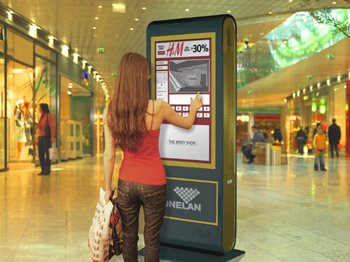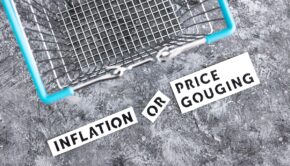Digital vision

Audience data collection and real time signage updates to match viewer age and gender are just a couple of things happening in digital visual solutions
12 June 2009
Perhaps early in the morning isn’t the best time to know your face is being scrutinised by sophisticated ‘face recognition’ technology.
Looking at a screen behind the name-badge desk at a recent POPAI Ireland breakfast briefing, a number of figures could be seen milling in various locations across the screen. On closer examination, it appeared one of them was, in fact, myself.
Vision Solutions, whose technical director Lisa Brockman was delivering a presentation on the subject, had cleverly decided to give a first-hand demonstration of what digital signage can now deliver.
The team had speedily installed the screens at the Clarion Hotel earlier that morning to show that not only can digital signage advertise products but can also be used as a means of audience data collection; based on who is looking at the screens and for how long. But far from being concerned with the size of one’s pores at eight in the morning, fortunately the technology concentrates more on ‘standard’ statistics such as age and gender.
Ivan O’Connor, managing director of ICE Tech believes such recognition technology will lead to exciting possibilities in the future. One of which is a ‘real time campaign’ that will automatically change the screen’s content according to who is looking at it. For example, when the technology determines that a man between 30 and 40 is looking at the sign, its customised display could switch to Gilette razors.
Chris Hirst, product marketing manager, Sony, outlines a further example of the kinds of functionality this technology can achieve. In Japan, people use Felica cards on the underground trains; they hold the cards up to a screen showing a particular promotion on the train, save this on their card, and later redeem it in a c-store. “But I think we’re still quite a way from that in the western world,” says Hirst.
Substantial price reductions
One thing technology providers are agreed on in the here and now however, is that the cost of such systems have come down enormously in recent years. Ivan O’Connor (ICE Tech) comments: “With large format displays coming down by 200% and 300% in price, it is possible to buy a digital signage solution now for €1,000, where you would have been paying €3,000 to €4,000 for the exact same solution only 18 months to two years ago.”
The digital systems have also become progressively easier to use, with the result that, O’Connor claims, retailers with just one unit can now achieve as much functionality as a 1000 unit enterprise. Cloud computing and broadband are largely responsible for allowing people to manage their systems better in his view. Basically, cloud computing means that all of the required software is hosted securely on the web, “so the retailer doesn’t have to worry about servers or content management.”
Chris Hirst (Sony) confirms the sector is “much more user-friendly than ever before.” Sony has a hardware board which slots into the side of its screens, and Hirst says this can be very easily updated with images or video that can be played on a loop. For example, the FW50 network streaming board, RRP of E390, allows retailers to choose the channel they want, so that for instance, all their stores in Dublin could play one ‘channel’ and all their Cork stores could play another.
Uplifting results
But while the price of such systems has dropped substantially, can digital signage deliver an equally substantial return on investment? Hirst says that in a trial Sony recently conducted in Ireland’s convenience sector, an 18% sales uplift occurred. However he does stress that “content is all important.” It is best to target content at securing impulse purchases at a store’s checkout. “If you highlight a Pepsi ‘buy one get one free’ offer, that kind of promotion will work, whereas if you’re just saying by the way we sell Pepsi, that won’t prove as effective.”
The retailer needs to balance the impact of the impulse promotion, versus the value of that sale to him or her. Says Hirst; “Sales might be up 18% but it might be a low margin earner for him, so it’s trying to balance [those two factors].” However, if a retailer can gain an 18% uplift on high margin or special offer goods, Hirst believes this a worthwhile result. Liam Sheehan, audio visual sales manager, Osmosis Ireland, distributors of Onelan solutions, adds that retailers can also charge vendors for advertising on their in-store screens.
Posted at La Poste
However, as well as directly contributing to higher profits, digital signage can deliver several other important benefits. It can grab customers’ attention and drive footfall into a store. It may also boost the shopper’s experience and their in-store education, by flagging up in-store services they may not have been aware of. Ambience can also be improved and the system can create less annoying waiting times, through providing general entertainment. For instance, Sony recently installed 2,500 screens across branches of French post office, La Poste. Hirst reports that feedback from this project has been extremely positive; illustrating that digital signage can work well within the convenience sector.

Ivan O’Connor, managing director of ICE Tech
According to Hirst, this delivers another financial benefit moreover in that it will use only 8W of power. For “2,500 screens over three years, this would represent an actual saving compared to a PC solution of a couple of million euros.”
However, while he believes digital signage can bring tangible results, in terms of increased impulse purchases and counter-side sales, he is not as convinced about using interactivity within the convenience sector. He sees this as something which may be more useful in a larger store or shopping centre, where customers could click on the screen to find the location of a particular shop.
Right time, right place
On the other hand, ICE Tech’s O’Connor believes interactivity in a c-store could include customers entering competitions, completing surveys or even joining a loyalty programme on-screen.
Digital signage also allows time-sensitive promotion. “With traditional signage,” says O’Connor, “you’re stuck with the same poster, whereas with digital signage you can bring in a special bundle that will just show around breakfast time. You might transfer that over to a coffee and a muffin deal after 10am so digital signage gives the ability to operate more effective promotions.”
Using digital signage instead of menu boards and traditional leaflets also cuts back on print costs. Says Osmosis’ Sheehan: “In retail where products can change frequently, content can be uplifted instantaneously whereas before there was a long time spent printing content on posters.” So it would appear that the writing’s not on the wall for digital signage in the current credit-crunched times. Au contraire; it’s on the screen.



 Print
Print





Fans 0
Followers